Kanklės
.jpg) Various Aukštaitian and Samogitian kanklės in the National Museum of Lithuania, end of 19th century - beginning of 20th century | |
| String instrument | |
|---|---|
| Other names | Kankliai, kunkliai, kunklaliai, kanklos, kanklys, kanklus, kunkl, kankalai[1], citra, psalteriumas, psalteris |
| Classification | Plucked string instrument, chordophone, zither |
| Hornbostel–Sachs classification |
314.122 (Diatonic lute-type stringed instrument) |
| Inventor(s) | Folk instrument |
| Related instruments | |
| Kokles, kannel, kantele, gusli, zither, psaltery, dulcimer | |
The kanklės (Lithuanian: [ˈkʌŋkles]) is a Lithuanian plucked string instrument (chordophone) belonging to the Baltic box zither family known as the Baltic psaltery, along with the Latvian kokles, Estonian kannel, Finnish kantele, and Russian gusli.
Etymology
According to Finnish linguist Eino Nieminen, the name of the instrument, along with the names of most of its neighbouring counterparts (Latvian kokles, Finnish kantele, Estonian kannel and Livonian kāndla), possibly comes from the proto-Baltic form *kantlīs/*kantlēs, which originally meant 'the singing tree',[2] most likely deriving from the Proto-Indo-European root *qan- ('to sing, to sound'; cf. Latin "canto, cantus, canticum", Italian "cantare", French "chanter", Englich "chant, cantor", Arab qanon or qanun ("instrument similar to kanklės"; word of Greek origin, derived from κανών).
"Citra" comes from German Zither, which comes from Greek kitharos.
"Psalteriumas" or "psalteris" (psalterium or psaltery) shows the usage of the instrument for accompanying the psalms[3][4] (cf. a book of psalms is also called psalterium or a psalter). In many cloisters in France kankles (psaltérion) is still used today to accompany the Liturgy of the Hours, which is based on psalms.
A Lithuanian ethnologist Romualdas Apanavičius believes Kanklės could be derived from the Proto-European root *gan(dh)-, meaning 'a vessel; a haft (of a sword)', suggesting that it may be related to the Russian word gusli.[5]
First written mention of the word "kanklės" occurs in 1580, in the Bible translation by Jonas Bretkunas. As a contrast, first written mention of Latvian kokles, a similar instrument, occurs in 1613.
Construction
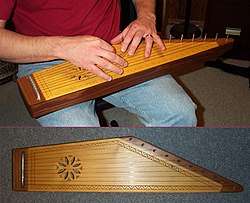
Although kanklės vary both regionally and individually, there are some common characteristics in their construction.
Kanklės belong to the zither family, which means that their strings are parallel to the soundboard (not perpendicular, like in a harp) and do not extend beyond it (not like in e.g. a guitar, where they extend to the neck). The body of the kanklės is made from one trapezoidal piece of linden tree, ash tree, oak, maple or black alder, which is hollowed out to create a cavity. A thin sheet of softwood (usually spruce) is used to make a soundboard, which covers the body.[5] Sound holes, which traditionally take the shape of a stylized flower or star, are cut into the soundboard, allowing sound to project outward.
At the narrowest side of the body, a metal bar is attached to which the strings made of wire or gut are anchored. The opposite ends of the strings are attached to a row of tuning pegs inserted into holes at the opposite side of the body.
Kanklės is usually rested on the player's lap and played with the fingers or a pick made of bone or quill.
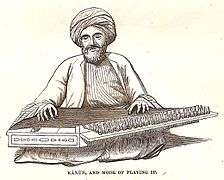
History
Most likely kanklės (zither, psaltery) developed from the instruments of the Near East: Persian santuri, Arabian kanon (a word of a Greek origin) or Jewish kinor.[6][7]
In Europe, there are written mentions of such a triangle instrument in the 5th century, under the Latin name nabulum[7][8] or nabulon[9].
Another opinion is that in Europe the zither or psaltery was introduced in the 11th century.
In any case, it was one of the main instruments from the 12th to the 15th centuries, varying widely in shape and number of strings, depicted in numerous drawings and sculptures. In neighboring Latvia there are kokles related archeological finds from 13th century.
According to Birutė Žalalienė (Visuotinė lietuvių enciklopedija), kanklės, coming from Western Europe, could be used in Lithuania to accompany church singing since the 15th century, and later, in Lithuania Minor and Samogitia - in folk music.[6]
Interestingly, when Ulrich von Jungingen in 1408 sent gifts for Ona Vytautiene, Grand duchess of Lithuania, he chose a portative organ and a clavichord, but not kankles.
Kankls are mentioned in Lithuanian territory for the first time, as a zither ("citra") in 1546, in accounts of Zigismund Augustus, mentioning "expenses for the metal parts of the zither".[10] Until then, there have been many mentions of wind instruments, sometimes drums and violin prototypes ("tympana, sambucae, fiolae") in describing the musicians of Gediminas' daughter Aldona,[10] but kankles, zither or psalter are never mentioned. However, tympanon is a kankles-type instrument in French.
The word "kanklės" is first used in writing in 1580 by Jonas Bretkunas, in his Bible translation.
Poet M. K. Sarbievius, professor of Vilnius university in the 17th century, played a zither, as well as a harp.[11]
Poet and publisict Vincas Kudirka could also play a zither, as well as violin and cello. Vincas Kudirka published two collections of folk songs, named "Kankles", in 1895 and 1898.[12]
Kanklės were manufactured in Kaunas at a factory of J. Garalevicius since 1901, and in Siauliai in 1933-1945 by J. Zaukis, according to J. Jankauskas' design. In Siauliai existed an amateur kankles ensemble during 1933-1945.[13]
Concert kanklės were first constructed in 1964, latvian concert kokles - in 1951.
In the King James Version of the Bible, "psaltery", and its plural, "psalteries", are used to translate several words whose meaning is now unknown: the Hebrew keli (כלי) in Psalm 71:22 and I Chronicles 16:5; nevel (נבל) in I Samuel 10:5; 2 Samuel 6:5; I Kings 10:12; I Chronicles 13:8; 15:16, 20, 28; 25:1, 6; II Chronicles 5:12; 9:11; 20:28; 29:25; Nehemiah 12:27; Psalms 33:2; 57:6; 81:2; 92:3; 108:2; 144:9; and 150:3; and the Aramaic pesanterin (פסנתרין) in Daniel 3:5, 7, 10, and 15.
Therefore, this term could be translated as kanklės. However, Rubsys and Kavaliauskas in 1998, choose to translate it either as "harp", "lyre" or "zither" ("arfa", "lyra", "citra"), although they choose the word "kanklės" in 1 Corinthians 14:7 (for the word "kithara") and Judges 5:11.
Types
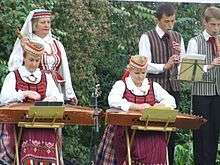
Apanavičius classifies the kanklės into three basic traditional types, although there are variations within each type and some overlap of areas. Each type has its own playing technique.[14]
- Kanklės of Northeastern Aukštaitians: the simplest and most ancient form. Carved out of a single piece of wood into a boat or coffin shape.
- Kanklės of Western Aukštaitians and Samogitians: somewhat larger than those of Northeastern Aukštaitija, usually having between eight and twelve strings. They have a flat bottom, and in some cases, the shortest end is carved with the stylized figure of a bird's or fish's tail.
- Kanklės of Northwestern Samogitians and Suvalkians: usually the most decorated type, and kanklės used in concert performance are most often based on this variety. The most prominent identifying feature is the addition of a carved spiral figure to the point of the instrument's body and sometimes, the rounding of the narrow end of the body. Typically these instruments have between nine and thirteen strings.[14]
Concert kanklės (pictured above), with an expanded range of more than four octaves (29 strings) and added chromaticism, provided by means of metal levers at the side of the instrument, similar to the ones used in a Celtic or lever harp, were constructed in 1964 by P. Kupčikas following the design of P. Stepulis and D. Mataitienė. They followed the lead of Latvian concert kokles, which were constructed in 1951 by Romāns Ķirpis for the Latvian folk music orchestra's soloist Helēna Kļava-Birgmeistere and had three-and-a-half octave range (25 strings). It in turn followed a German concert zither, constructed by Nikolaus Weigel in Munich in 1838.
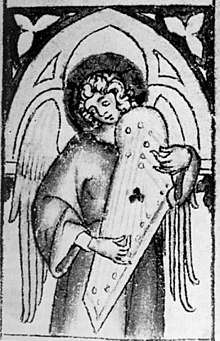
References
- ↑ Tarnauskaitė-Palubinskienė 2009, p. 477
- ↑ Williams, Roger, ed. (1993). "The Singing Tree". Insight Guides: Baltic States. APA Publications (HK) Ltd. p. 85. ISBN 978-9624-2118-2-5. Retrieved March 30, 2017.
- ↑ "Psaltérion", Wikipédia (in French), 2017-10-09, retrieved 2018-09-22
- ↑ "psalterion". apemutam.free.fr. Retrieved 2018-09-22.
- 1 2 Žalalienė, Birutė. "Visuotinė lietuvių enciklopedija: Psalteriumas".
- 1 2 "Psaltérium", Wikipedie (in Czech), 2017-02-02, retrieved 2018-09-23
- ↑ Annales archéologiques (in French). Libr. Archéologique de Didron. 1845.
- ↑ "Le psaltérion à dix cordes | L'Annonciade". www.annonciade.info (in French). Retrieved 2018-09-23.
- 1 2 "Vita Antiqua - Muzikinis gyvenimas Vilniaus Žemutinėje Pilyje". www.antiqua.lt. Retrieved 2018-09-22.
- ↑ Trilupaitienė, J. Opera Lietuvos didžiųjų kunigaikščių rūmuose. p. 13.
- ↑ "Kudirka vincas". www.slideshare.net. Retrieved 2018-09-22.
- ↑ "citra". www.vle.lt. Retrieved 2018-09-22.
- 1 2 Tarnauskaitė-Palubinskienė 2009, pp. 478–480
Bibliography
- Tarnauskaitė-Palubinskienė, Vida (2009). Kanklės lietuvių etninėje kultūroje [Kanklės in the Ethnic Culture of Lithuanians]. Vilnius: Lithuanian University of Educational Sciences. ISBN 978-9955-20-449-7.
External links
| Wikimedia Commons has media related to Kanklės. |
- Lithuanian stringed instrument kanklės
- Anthology of Lithuanian Ethnoculture
- David McNamee: Hey, what's that sound: Zithers and autoharps. The Guardian, 18 May 2011
 A Belgian dulcimer, similar to kankles
A Belgian dulcimer, similar to kankles - Encyclopaedia Britannica: Zither
- Kankles (zither), looking like an autoharp, at the Museum of Kaunas City
- Kanklės (zithers) in Lithuanian museums
- Webpage of a maker of French kankles (psaltérion)
- Kanklės (zithers) from Leipzig City Museum
- Exhibition of Lithuanian folk instruments at the National Museum of Lithuania
- Picture of an older version of German zither (kanklės), second half of the 18th century (below) and Egyptian qanun, end of 19th century (above); Museum of Munich
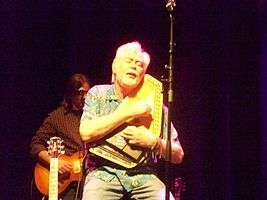
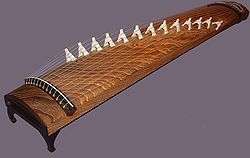
See also
- Zither
- Psaltery
- Kokles
- Kantele
- Kannel
- Salterio
- Psalterium (German)
- Cytra (Polish)
- Tympanon (fr.)
- Hammered dulcimer
- Scheitholt
- Autoharp
- Marxophone
- Celestaphone
- Langeleik
- Langspil
.jpg) Variety of European zithers (kanklės)
Variety of European zithers (kanklės) - Epinette des Vosges
- Spitzharfe
- Epigonion
- East Slavic gusli
- Turkish qanun
- Chinese guzheng
- Japanese koto
%2C_Autoharp%2C_etc_-_MIM_PHX.jpg) Variety of fretless zithers at a museum
Variety of fretless zithers at a museum Venetian kankles (salterio), around 1700Cymbaly (Polish)
Venetian kankles (salterio), around 1700Cymbaly (Polish)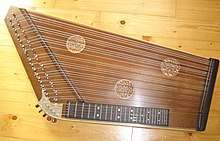 German concert kanklės (zither)
German concert kanklės (zither)- Appalachian dulcimer